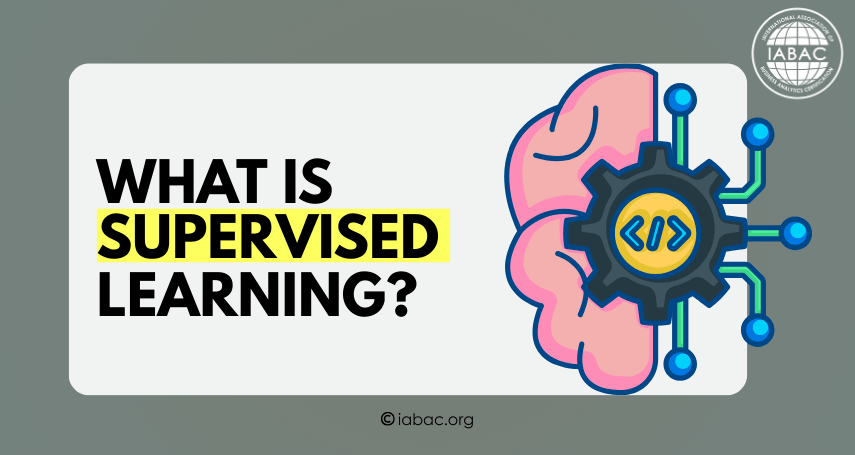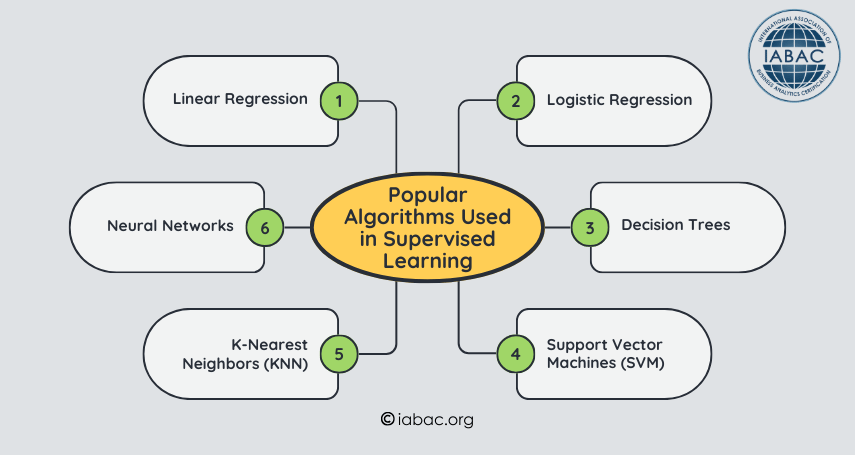What is Supervised Learning? | IABAC
 seenivasan V
seenivasan V
#
Machine learning, which allows computers to learn from data, is transforming industries in the world of today. Supervised learning is one of the most popular and essential strategies among the many machine learning methods. Many real-world applications, including speech recognition, image categorization, spam detection, and predictive analytics, depend on it as their basis.
The fundamental ideas of supervised learning, its operation, its uses, and more will all be covered in the present post. This essay will provide you with a thorough understanding of machine learning, regardless of your level of experience.
What Do You Mean by Supervised Learning?
A kind of machine learning called supervised learning uses labeled data to teach the model. The word "supervised" refers to an idea that a teacher or supervisor, in this situation, the labeled dataset, guides the learning process.
The algorithm is given a dataset with input-output pairs in supervised learning. The model learns to translate the inputs to the appropriate outputs, and each input has a corresponding label or output. The model can predict new, unseen data after it has been trained.
Example:
Imagine you want to build a model to identify whether an email is spam or not. You start with a dataset containing thousands of emails, each labeled as "spam" or "not spam." This dataset is used to train a model. Once trained, the model can predict whether a new, unlabeled email is spam.
Key Terminologies in Supervised Learning
To understand, it is essential to understand the following terminology:
Features (X): These are the factors utilized to create predictions. For example, the text in an email.
Labels (Y): The appropriate outputs for every input are shown here. For example, if it is spam or not.
Training Data: The dataset that the model is trained on. There are input-output pairs in it.
Test Data: An independent dataset that is used to assess how well the model performs on data that hasn't been seen.
Model: The representation of inputs to outputs that the algorithm generates mathematically.
How Does Supervised Learning Work?
This process can be divided into several key steps:
1. Data Collection
The first step is gathering a dataset with labeled examples. The quality and quantity of this data are crucial to the success of the model.
2. Data Preprocessing
The data frequently requires preprocessing and cleaning before training. Managing missing values, standardizing data, and transforming categorical variables into numerical ones may all be part of this.
3. Splitting the Dataset
The dataset is usually split into training and testing sets. A common split is 80% for training and 20% for testing.
4. Model Selection
Choose a suitable algorithm to train your model. Common choices include decision trees, support vector machines (SVM), neural networks, and linear regression.
5. Training the Model
The algorithm processes the training data and learns the mapping from input features to output labels.
6. Model Evaluation
The test set is used to evaluate the model following training. To assess the model's performance, performance metrics including as precision, recall, accuracy, and the F1-score are used.
7. Making Predictions
Once satisfied with the model's performance, it can be used to make predictions on new data.
Types of Supervised Learning
It is classified into two categories:
1. Classification
In classification tasks, the goal is to predict a categorical label. Examples include:
Email spam detection (spam or not spam)
Disease diagnosis (positive or negative)
Image recognition (cat, dog, or bird)
2. Regression
In regression tasks, the goal is to predict a continuous value. Examples include:
Predicting house prices
Predicting stock prices
Estimating temperature
Popular Algorithms Used in Supervised Learning
There are several algorithms used in supervised learning, each with its strengths and weaknesses. Some of the most popular ones include:

1. Linear Regression
Used for regression problems, it models the relationship between input variables and the output using a straight line.
2. Logistic Regression
Used for binary classification problems. Despite its name, it's used to classify data rather than perform regression.
3. Decision Trees
A model that divides data into branches in order to generate predictions, much to a flowchart. It is easy to learn and understand.
4. Support Vector Machines (SVM)
Powerful classifiers that work well for high-dimensional data.
5. K-Nearest Neighbors (KNN)
A non-parametric technique that organizes a data point according to the classification of its neighbors.
6. Neural Networks
Inspired by the human brain, neural networks are powerful and can model complex relationships.
Advantages of Supervised Learning
High Accuracy: This algorithm can get high accuracy when given quality data.
Clear Goal: It is simple to assess model performance when labeled data is available.
Broad Application: Useful for a variety of issues, including those in healthcare and finance.
Real-World Applications of Supervised Learning
This powers many technologies we use daily:
Email Filtering: Determining if an email is spam or not.
Credit Scoring: Predicting Loan Defaults.
Medical Diagnosis: The identification of diseases based on their symptoms and test results.
Voice Recognition: The process of converting speech to text.
Customer segmentation: Predicting customer churn.
One of the fundamental ideas in machine learning is supervised learning. It provides strong prediction and categorization skills by empowering robots to make defensible conclusions based on past facts.
You can better utilize it in practical situations if you understand how it operates, the kinds of issues it resolves, and the techniques it uses. It will continue to be an essential tool in the machine learning toolkit as data volume and significance continue to increase.
It provides the methods and resources to turn your concepts into clever ideas, whether your goal is to create a recommendation engine, identify diseases, or predict trends.
Subscribe to my newsletter
Read articles from seenivasan V directly inside your inbox. Subscribe to the newsletter, and don't miss out.
Written by
